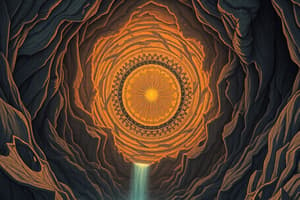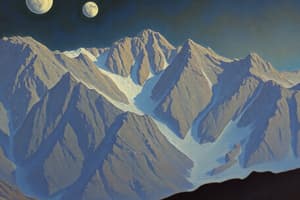Podcast
Questions and Answers
What is the reason for the seasons on Earth?
What is the reason for the seasons on Earth?
- Solar activity
- Earth's rotation speed
- Distance from the Sun
- Earth's tilt (correct)
Which layer of the Earth is the thinnest?
Which layer of the Earth is the thinnest?
- Crust (correct)
- Mantle
- Outer core
- Inner core
What phenomenon occurs due to the magnetic field generated by the Earth's outer core?
What phenomenon occurs due to the magnetic field generated by the Earth's outer core?
- Tsunamis
- Auroras (correct)
- Volcanoes
- Eclipses
How long does it take for Earth to complete one full rotation on its axis?
How long does it take for Earth to complete one full rotation on its axis?
What is the temperature of the Earth's outer core?
What is the temperature of the Earth's outer core?
Which law states that the orbits of planets are elliptical?
Which law states that the orbits of planets are elliptical?
What materials primarily constitute the oceanic crust?
What materials primarily constitute the oceanic crust?
What is the main reason the inner core remains solid despite high temperatures?
What is the main reason the inner core remains solid despite high temperatures?
What type of eclipse occurs when the sun, earth, and moon align along a straight path?
What type of eclipse occurs when the sun, earth, and moon align along a straight path?
During which type of eclipse is the moon completely obscured by the earth's umbra?
During which type of eclipse is the moon completely obscured by the earth's umbra?
Which shadow is formed during a solar eclipse?
Which shadow is formed during a solar eclipse?
In what condition does an annular solar eclipse occur?
In what condition does an annular solar eclipse occur?
Which of the following describes a partial lunar eclipse?
Which of the following describes a partial lunar eclipse?
What phenomenon is commonly referred to as a blood moon?
What phenomenon is commonly referred to as a blood moon?
Which shadow can be seen during a partial solar eclipse?
Which shadow can be seen during a partial solar eclipse?
What can be observed during a total lunar eclipse?
What can be observed during a total lunar eclipse?
What happens to a planet's speed as it approaches the sun?
What happens to a planet's speed as it approaches the sun?
Which law states that a planet's angular momentum stays the same as it orbits the Sun?
Which law states that a planet's angular momentum stays the same as it orbits the Sun?
What does Newton's 2nd Law of Motion explain about planets?
What does Newton's 2nd Law of Motion explain about planets?
According to Kepler’s 3rd Law, what happens to a planet's orbital period as it is farther from the sun?
According to Kepler’s 3rd Law, what happens to a planet's orbital period as it is farther from the sun?
How does the gravitational attraction between the sun and a planet affect the planet's movement?
How does the gravitational attraction between the sun and a planet affect the planet's movement?
What does Newton's 3rd Law of Motion state about interactions between the sun and a planet?
What does Newton's 3rd Law of Motion state about interactions between the sun and a planet?
What causes the ocean tides on Earth?
What causes the ocean tides on Earth?
What is the main reason for a planet's inertia while orbiting the sun?
What is the main reason for a planet's inertia while orbiting the sun?
Flashcards are hidden until you start studying
Study Notes
Shape of the Earth
- The Earth is slightly bulging at the equator and flattened at its poles.
Earth's Motions
- Rotation: The Earth rotates on its axis, completing one rotation in 23 hours, 56 minutes, and 4 seconds. This causes day and night.
- Revolution: The Earth revolves around the Sun in an elliptical orbit, completing one revolution in 365.25 days.
Magnetic Field of the Earth
- The Earth's magnetic field is generated by the movement of molten iron and nickel in the liquid outer core.
- The magnetic field is responsible for the auroras (northern and southern lights) observed in the thermosphere.
Earth's Seasons
- The Earth's tilt is responsible for the seasons.
Layers of the Earth
- Crust: Thin and outermost layer, composed of two types:
- Continental Crust: Less dense, made up of rocks like granite.
- Oceanic Crust: Denser, made up of rocks like basalt.
- Mantle: Thickest layer, located beneath the crust, with increasing temperature as depth increases.
- Outer Core: Found 2,900 km below the Earth's surface, composed of liquid iron and nickel, with a temperature of up to 2000 ℃.
- Inner Core: Hottest layer, where iron and nickel are solidified due to the immense pressure.
Kepler's Laws of Planetary Motion
- 1st Law (Law of Orbits): Planets orbit the Sun in elliptical paths, not circular.
- 2nd Law (Law of Areas): The imaginary line connecting a planet to the Sun sweeps equal areas in equal intervals of time.
- 3rd Law (Law of Periods): The farther a planet is from the Sun, the longer it takes to orbit.
Newton's Laws of Motion
- 1st Law (Law of Inertia): An object at rest stays at rest, and an object in motion remains in motion at a constant speed and direction unless acted upon by a net external force.
- 2nd Law (Law of Acceleration): The acceleration of an object is directly proportional to the net force acting on it and inversely proportional to its mass (F = ma).
- 3rd Law (Law of Interaction): For every action, there is an equal and opposite reaction.
Earth's Moon
- The Moon is the Earth's only natural satellite.
- Lunar craters are formed from volcanic activity, collisions, and impacts with other celestial objects.
- Tides are affected by gravitational attraction between the Moon, Earth, and the Sun.
- Spring Tide: Occurs when the Sun, Earth, and Moon align, resulting in higher high tides and lower low tides.
- Neap Tide: Occurs when the Sun, Earth, and Moon are at right angles, resulting in smaller tidal variations.
Eclipses
- Occur when the Sun, Earth, and Moon align in a straight path.
- Shadows are formed during eclipses:
- Umbra: The darkest part of a shadow.
- Penumbra: The lighter part of a shadow.
- Antumbra: A conical shadow behind the umbra.
- Solar Eclipse: Occurs when the Moon passes between the Sun and Earth, blocking the Sun's light.
- Total Solar Eclipse: The Moon completely covers the Sun, creating the darkest part of the shadow (umbra).
- Partial Solar Eclipse: Only part of the Sun is covered.
- Annular Solar Eclipse: The Moon is far from Earth and appears smaller than the Sun, creating a ring (annulus) of sunlight around the Moon.
- Lunar Eclipse: Occurs when the Earth passes between the Sun and Moon, casting its shadow on the Moon.
- Total Lunar Eclipse: The Moon is entirely within the Earth's shadow.
- Partial Lunar Eclipse: Only part of the Moon is within the Earth's shadow.
Studying That Suits You
Use AI to generate personalized quizzes and flashcards to suit your learning preferences.



